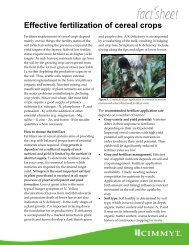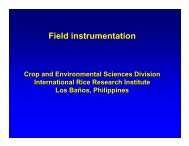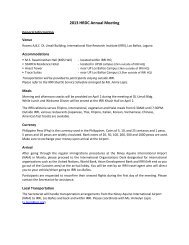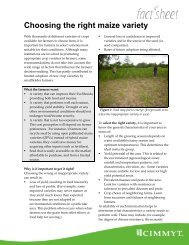Rice Fact sheet - Rice Blast - Rice Knowledge Bank - International ...
Rice Fact sheet - Rice Blast - Rice Knowledge Bank - International ...
Rice Fact sheet - Rice Blast - Rice Knowledge Bank - International ...
You also want an ePaper? Increase the reach of your titles
YUMPU automatically turns print PDFs into web optimized ePapers that Google loves.
<strong>Rice</strong> <strong>Blast</strong><br />
<strong>Rice</strong> <strong>Blast</strong> – Page 1 of 3<br />
Nature and disease symptoms<br />
<strong>Rice</strong> blast is one of the most important diseases of rice, caused by the fungus Magnaporthe oryzae B.C.<br />
Couch (Couch and Kohn 2002). The pathogen may infect all the aboveground parts of a rice plant at<br />
different growth stages: leaf, collar, node, internode, base, or neck, and other parts of the panicle, and<br />
sometimes the leaf sheath. A typical blast lesion on a rice leaf is gray at the center, has a dark border,<br />
and is spindle-shaped (large in the middle and tapering toward the end; Fig. 1a).<br />
rice fact <strong>sheet</strong>s<br />
Under favorable conditions, leaf lesions enlarge and coalesce, eventually blighting the entire leaf. Leaf<br />
blast lesions on some varieties are sometimes similar to brown spot lesions. Collar blast causes reddish<br />
brown to brown collar lesions (Fig. 1b) and may kill the entire attached leaf. In the case of node blast,<br />
the node turns blackish (Fig. 1c) and breaks easily. Neck blast results in a girdled neck with grayish<br />
brown lesions (Fig. 1d). These different symptoms have very different consequences for rice yield<br />
(Pinnschmidt et al 1994), and neck blast is potentially the most destructive. Neck blast may be<br />
confused with “whiteheads” caused by stem borer injuries. Both injuries result in empty, erect, whitegray,<br />
and conspicuously injured panicles. However, unlike injury caused by stem borer, for which the<br />
entire stem can be pulled out readily, neck blast causes only injury at the neck, and normally does not<br />
extend further into the leaf sheath.<br />
a b c d<br />
Fig. 1. <strong>Blast</strong> lesions on the leaf (a), collar (b), node (c) and neck (d) of a rice plant.<br />
Occurrence of blast<br />
<strong>Rice</strong> blast is present wherever rice is cultivated, but the disease occurs with highly variable intensities,<br />
depending on climate and cropping system. Environments with frequent and prolonged dew periods and<br />
with cool temperature in daytime are more favorable to blast. This applies particularly to upland and<br />
rainfed environments in the tropics and subtropics, as well as irrigated areas in temperate ecosystems.<br />
<strong>Fact</strong>ors favoring the disease<br />
The literature concerning factors that may influence blast is extensive, and can be only briefly<br />
summarized here (Teng 1994). The early literature emphasized the many physical and micro-climatic<br />
factors that may influence the life cycle of the pathogen (e.g., Hashimoto 1981), including spore<br />
liberation, transport, deposition, infection, latency, and sporulation. For each phase of the life cycle, an<br />
optimum of environmental factors often exists for blast. Thus, subtropical or temperate environments,<br />
where canopy wetness is frequent along with moderate temperature, are particularly inducive to blast.<br />
A considerable amount of work has been devoted to studying pathogen-host-environment<br />
interrelationships in blast. Excessive nitrogen fertilizer promotes the disease. On the other hand,<br />
moderate water stress also favors the disease, especially the sporulation of the pathogen. <strong>Blast</strong> can be<br />
a major disease of both lowland and upland rice, under favorable conditions—for example, extended<br />
duration of leaf wetness, a high amount of nitrogen, and cool temperature.<br />
For more information, visit the <strong>Rice</strong> <strong>Knowledge</strong> <strong>Bank</strong>: http://www.knowledgebank.irri.org<br />
To diagnose problems in the field, visit www.knowledgebank.irri.org/ricedoctor.<br />
Developed with input from: N. Castilla, S. Savary, C.M. Vera Cruz, and H. Leung<br />
Produced by the <strong>International</strong> <strong>Rice</strong> Research Institute (IRRI) • © 2010 IRRI, All rights reserved • Mar 2010
<strong>Rice</strong> <strong>Blast</strong> – Page 2 of 3<br />
Detailed quantitative knowledge of the life cycle, aided by simulation modeling studies (Teng 1994),<br />
provides an entry point for devising strategies for disease control, including the use of host-plant<br />
resistance. In general, the severity of leaf blast epidemics is dependent on two key phases of the<br />
disease cycle: infection (a deposited pathogen spore infects a healthy leaf site) and sporulation (the<br />
amount of spores produced by a blast lesion over an infectious period). Achieving control over these two<br />
stages is known to effectively control the disease. Resistant rice varieties probably confer resistance<br />
through interference of the infection and sporulation processes.<br />
Another critical factor that determines the likelihood of a blast epidemic is related to the genotype of the<br />
rice variety that is cultivated, to the diversity of the pathogen that is present, and their interaction.<br />
rice fact <strong>sheet</strong>s<br />
The rice blast pathosystem is a model system for basic studies by biologists. The blast fungus, with its<br />
high degree of genetic variability, has attracted interest in pathogen genetics and evolution. The genome<br />
of the blast fungus has been sequenced. The available genomics tools in rice and in the fungus have<br />
offered many opportunities for investigation of host-pathogen interaction, disease resistance, pathogen<br />
population genetics, and evolution.<br />
Control of rice blast<br />
Host plant resistance<br />
Host-plant resistance is, by far, the primary control option for blast, in spite of the difficulties this disease<br />
represents in developing durable and efficient resistances.<br />
The molecular genetics of blast resistance has been extensively studied (Jena and Mackill 2008),<br />
leading to many DNA markers corresponding to major resistance genes identified. Some 40 genes for<br />
major resistance to blast are known. Reliance on major resistance genes, however, is risky because<br />
new genotypes of the pathogen can evolve rapidly and overcome host resistance (Zeigler et al 1994).<br />
Nonetheless, some resistance genes are found to confer broad-spectrum resistance against pathogen<br />
strains tested. Partial resistance, on the other hand, is usually controlled by multiple genes, and it may<br />
offer a more stable form of resistance. Combining broad-spectrum resistance genes with multiple<br />
quantitative resistance genes may be a promising approach to develop durable resistance (Jena and<br />
Mackill 2008, Manosalva et al 2009).<br />
In some situations, blast can be managed through the use of diverse varieties with different levels of<br />
resistance and modified cultural practices. Good control of panicle blast can be achieved through<br />
interplanting rice varieties (Zhu et al 2000). Multilines, comprising several near-isogenic lines each<br />
carrying different resistance genes, have been successfully used to control blast in Japan (Koizumi<br />
2001).<br />
Crop management<br />
Split applications of nitrogen based on actual requirements of the crop are recommended to reduce<br />
disease intensity. The excessive use of nitrogen fertilizer promotes luxuriant crop growth, which<br />
increases the relative humidity and leaf wetness of the crop canopy, and so favors blast. Flooding the<br />
soil as often as possible can be effective, particularly in tropical areas where conditions are not very<br />
favorable to blast.<br />
The application of silicon fertilizers (e.g., calcium silicate) to soils that are deficient in this element has<br />
reduced blast. Because of its high cost, silicon should be applied efficiently. Cheap sources of silicon,<br />
for example, straw of rice genotypes with high silicon content, can be considered to make this approach<br />
economically viable.<br />
Chemical control<br />
Many fungicides have been developed to control blast, which represents the second fungicide market<br />
worldwide. Systemic fungicides are often used to control blast in many rice-growing areas. The use of<br />
fungicides with similar modes of action over extensive periods is not recommended because it has<br />
resulted in the emergence of resistant populations of the pathogen (Kim et al 2008).<br />
For more information, visit the <strong>Rice</strong> <strong>Knowledge</strong> <strong>Bank</strong>: http://www.knowledgebank.irri.org<br />
To diagnose problems in the field, visit www.knowledgebank.irri.org/ricedoctor.<br />
Developed with input from: N. Castilla, S. Savary, C.M. Vera Cruz, and H. Leung<br />
Produced by the <strong>International</strong> <strong>Rice</strong> Research Institute (IRRI) • © 2010 IRRI, All rights reserved • Mar 2010<br />
2
<strong>Rice</strong> <strong>Blast</strong> – Page 3 of 3<br />
References<br />
Couch BC, Kohn LM. 2002. A multilocus gene genealogy concordant with host preference indicates<br />
segregation of a new species, Magnaporthe oryzae, from M. grisea. Mycologia 94:683-693.<br />
Hashimoto A. 1981. Water droplets on rice leaves in relation to the incidence of leaf blast: use of the<br />
dew balance for forecasting the disease. Rev. Plant Prot. Res. 14:112-126.<br />
rice fact <strong>sheet</strong>s<br />
Jena KK, Mackill DJ. 2008. Molecular markers and their use in marker-assisted selection in rice. Crop<br />
Sci. 48:1266-1276.<br />
Kim YS, Oh JY, Hwang BK, Kim KD. 2008. Variation in sensitivity of Magnaporthe oryzae isolates from<br />
Korea to edifenphos and iprobenfos. Crop Prot. 27:1464-1470.<br />
Koizumi S. 2001. <strong>Rice</strong> blast control with multilines in Japan. In: Mew TW, Borromeo E, Hardy B, editor.<br />
Exploiting biodiversity for sustainable pest management. Los Baños (Philippines): <strong>International</strong> <strong>Rice</strong><br />
Research Institute. p 143-157.<br />
Manosalva, PM, Davidson RM, Liu Bin, Zhu XY, Hulbert SH, Leung H, Leach JE. 2009. A germin-like<br />
protein gene family functions as a complex quantitative trait locus conferring broad-spectrum disease<br />
resistance in rice. Plant Physiol. 149:286-296.<br />
Pinnschmidt HO, Teng PS, Luo, Y. 1994. Methodology for quantifying rice yield effects of blast. In:<br />
Zeigler RS, Leong SA, Teng PS, editors. <strong>Rice</strong> blast disease. Wallingford, Oxon (United Kingdom): CAB<br />
<strong>International</strong>, Los Baños (Philippines): <strong>International</strong> <strong>Rice</strong> Research Institute. p 381-408.<br />
Teng PS. 1994. The epidemiological basis for blast management. In: Zeigler RS, Leong SA, Teng PS,<br />
editors. <strong>Rice</strong> blast disease. Wallingford, Oxon (United Kingdom): CAB <strong>International</strong>, Los Baños<br />
(Philippines): <strong>International</strong> <strong>Rice</strong> Research Institute. p 409-434.<br />
Zeigler RS, Leong SA, Teng PS, editors. 1994. <strong>Rice</strong> blast disease. In: Zeigler RS, Leong SA, Teng PS,<br />
editors. <strong>Rice</strong> blast disease. Wallingford, Oxon (United Kingdom): CAB <strong>International</strong>, Los Baños<br />
(Philippines): <strong>International</strong> <strong>Rice</strong> Research Institute. 626 p.<br />
Zhu Y, Chen H, Fan JH, Wang Y, Li Y, Chen J, Fan JX, Yang S, Hu L, Leung H, Mew TW, Teng PS,<br />
Wang Z, Mundt CC. 2000. Genetic diversity and disease control in rice. Nature 406:718-722.<br />
For more information, visit the <strong>Rice</strong> <strong>Knowledge</strong> <strong>Bank</strong>: http://www.knowledgebank.irri.org<br />
To diagnose problems in the field, visit www.knowledgebank.irri.org/ricedoctor.<br />
Developed with input from: N. Castilla, S. Savary, C.M. Vera Cruz, and H. Leung<br />
Produced by the <strong>International</strong> <strong>Rice</strong> Research Institute (IRRI) • © 2010 IRRI, All rights reserved • Mar 2010<br />
3


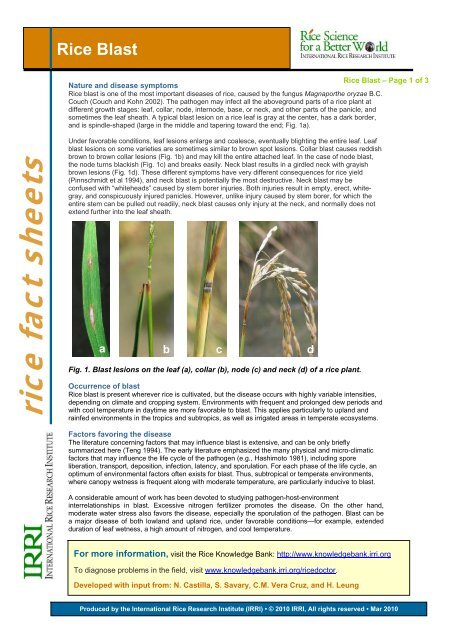


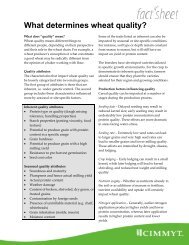


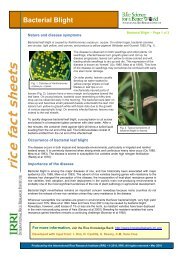

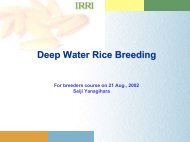
![International Standards' Organization â Rice Specification [ISO 7301]](https://img.yumpu.com/36696862/1/190x245/international-standards-organization-a-rice-specification-iso-7301.jpg?quality=85)

